|
Qi Energy Exercises
|
What Is Qi Energy?Qi (Chi) Explained and How to Use It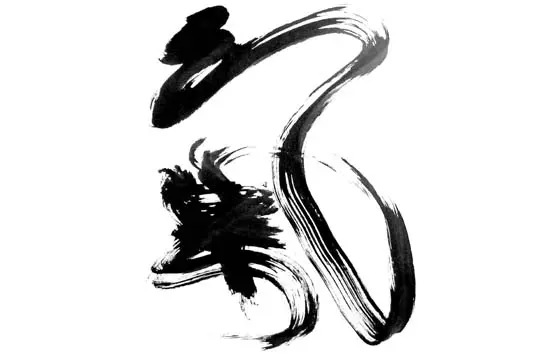 Qi. Calligraphy by the author. Qi is the Chinese term for life energy, or life spirit, a vital force that flows through all living things. It is an essential part of acupuncture, qigong, reiki, and the martial arts of the East, among other things. There is no mystery to it.
The nearest Western equivalent to qi energy is inspiration. But there is a decisive difference between Eastern and Western attitudes. Westerners tend to regard this sweet spiritual inebriation as something that either fills us or deserts us, completely out of our control. In the Eastern mind, though, this is something that you can control. You can awaken, stimulate, increase and utilize the qi energy, according to your will. Therefore, this text is focused on the strictly practical aspects of qi energy: how to get it started and make it grow, and how to use it. Inspiration is yours to call upon at your own wish. It is not even difficult. The exercises in this book are quite rudimentary, and anyone can do them without effort. Nor do they take much time. There is just one snag: You have to repeat them, preferably every day, and you should do that long enough to establish new habits. It is the only method to make your body act in a way that stimulates your qi, without your mind having to think about it constantly. You will soon find that life gets another luster. So give it a chance.
Spirit and breathThe word inspiration is directly linked to breathing. It comes from the Latin word for inhaling, which can also mean blowing into something, or even blowing life into something. Its root is the word spiritus, spirit, which originally means breath.Qi, too, is primarily linked to breathing — so closely that it is sometimes difficult to point out their differences. Qi enters and exits the body, like the air does in breathing. And both directions are just as necessary — old qi must exit in order for new qi to enter. Nonetheless, there is a difference. Although qi can be compared to the air that is inhaled and exhaled, they are not identical. Qi is more like something hiding within the air we breathe, a necessary essence that the body receives through the breathing. Thereby it is closer to oxygen, the substance that breathing is really all about. The body needs oxygen for its interior combustion, and the oxygen is hidden inside the air. We get new oxygen by breathing in, and get rid of the excess air by breathing out.
If we cannot accept the idea of a so far undiscovered ether as a kind of life force behind the scene, and search for a scientific explanation for the notion of qi, then oxygen and its function seem to be a likely start. Already primordial man must have noticed that breathing is necessary for survival, and that the dead have stopped doing it. Even without a laboratory at hand, our ancestors would have come to the conclusion that there is something in the air that makes us live and walk about. Another similarity between qi and oxygen might not be perceived the same by all individuals: Taking a deep breath of fresh air is inspiring, invigorating to the spirit. On the contrary, breathing stale air induces drowsiness and quite possibly a headache. Whether this has to do with oxygen or qi is difficult to say — here they are too closely linked. A lack of oxygen is sure to bring your mood down, at length even to kill you. That is also said about qi. When there is oxygen or qi in abundance, you get lively and inspired. They seem to do the same, so they may be the same. But there are differences between oxygen and qi. Although the flow of qi is similar to that of oxygen, it is not equally bound to certain bodily organs. Qi flows in and out of the body, independent of the lungs, the veins and arteries. You can even have a flow of qi when you hold your breath. And qi extends far beyond the body, which is something that the oxygen you breathe is unable of. So, if you want to understand and try qi, it is important not to get stuck on the thought of qi as nothing but a kind of symbol for breathing. Qi is a unique ether, with only superficial similarities to the air we breathe. The vitalization that qi brings might not be as biologically critical as oxygen, but instead it is infinitely more inspiring.
The ether of intentionMany would call qi nothing but a thing of the imagination, a misconception belonging to the distant past of man, when countless puzzling phenomena of nature could only be met by guesses and speculation. Maybe it is so — I do not insist on some scientific validity of qi. The question is not even that interesting to me. Whether qi is reality or superstition, it works on what it is to achieve.A good flow of qi is by its nature healing and wonderfully inspiring. Also, by focusing on the qi flow we can accomplish things that are much more difficult without it, if they are at all possible. Qi does what it should, whether it exists or not. This points out another similarity — the one between qi and a phenomenon that is well known in the western world: fantasy. Maybe qi is an expression of the power of fantasy. Why not? Still, fantasy is normally linked to dreams and the dreamlike, while qi belongs to being and acting, very much awake. I would prefer to connect qi to willpower and wish. The mental phenomenon that is the closest to qi is intention — when you set your mind to something, or decide to do something. Qi can be called the ether of intention, a kind of energy by which you accomplish what you set your mind to. Just by directing yourself at something, you get your qi flowing, whether you are aware of it or not. So, it can be called willpower. In the East, willpower is regarded as an obvious expression of qi.
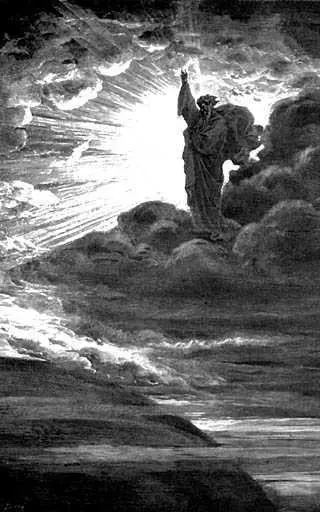 Let there be light! Illustration by Gustave Doré. Let there beIn its foremost appearance, qi is the human equivalent of the divine "let there be" by which the Bible states that the creation of the world commenced. In the Book of Genesis, God created the whole world in six days by ordering its components forward: "Let there be light!" and so on. In this mythological primary expression of intention, the universe and life appeared, moving in their intricate orbits and following the conditions of the primordial "let there be" ever since.A human "let there be" hardly has the same dignity, and is unable that grand scale, but it is still just as fantastic: I am, I look around, and I wish something. We create small things and big ones, news and reruns, artistic masterpieces and catastrophes. In this, we are the image of God: the ability to create. Without intention, nothing is created. We just vegetate on what surrounds us. When instead — for good or bad — we deal with our reality so that we perceive, approach and transform it, then we are filled with inspiration, and we flow of qi.
Meridians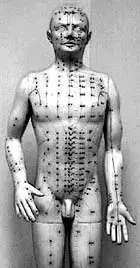 The Chinese tradition about qi is so old that its origin is unlikely to be dated. By time, it has become a vast and complex doctrine.
The Chinese tradition about qi is so old that its origin is unlikely to be dated. By time, it has become a vast and complex doctrine.Chinese natural medicine treats the qi flow as something mainly contained within the body, similar to the circulatory system of the blood. The qi equivalent is a number of so called meridians. They are used in acupuncture. Needles are inserted to stimulate points and lines along these meridians, which are meticulously mapped on drawings of the human body, or on acupuncture dolls. For the purpose of this book, though, the complex patterns of acupuncture meridians are not necessary. Actually, I am in doubt of their relevance — although both acupuncture and acupressure have proven to accomplish quite a lot by using them. Let us just say that one must crawl before one can walk. The reader who gets a strong and stimulating qi flow through the exercises of this book, might be inclined to move on by researching the meridians. That is likely to be rewarding, as well.
ChakraThere is one fundamental channel of qi, which can be called a meridian. It has its origin in the Indian tradition that is possibly even older than the Chinese one. India has a concept called kundalini, a vitalizing and spiritually refining power that runs from the pelvis up to the top of the head — a vertical line through the middle of the body.Along this line there are seven chakras. The word chakra originally means wheel, and implies rotation. The word kundalini means curled, like a serpent at rest.
The Indian tradition teaches that you can rise from a simple level to one close to the gods, by allowing your life spirit to flow upward this line, through each chakra — to the seventh, the crown chakra, which gives spiritual awakening. The Indian name for the life spirit is prana, something that is completely comparable to qi.
The centerAlso the Indian tradition has by time become very complex and partially close to impenetrable. But we do not need to get into that either, for the exercises in this book. The very basics, which are the same in India and China, will suffice.We will use one chakra, the second from below. It is in the abdomen, a couple of inches below the navel, and that is also the position of the body's center of mass. This point works as a center for the qi flow. To exercise one's qi flow without any kind of center is difficult at length. Certainly, you can get to know qi and make it flow, but without a center you become passive, almost like a victim, and have a hard time using qi according to your own will. It is like being adrift at sea. Intention can be described as a direction, but it needs a source, a starting point. You benefit from placing such a starting point in one of your chakras. You could actually choose any of the seven basic chakras of the Indian tradition, but the higher up you go, the more difficult it gets for the inexperienced practitioner to feel something substantial. This is stressed by the Indian teaching, which states that the kundalini movement is from the bottom up. Then it would make sense to start with the very root chakra, called Muladhara in Indian, meaning root. It is at the pelvis, where the genitals are. Indeed, it is quite possible to base one's exercises on this chakra. India has a rich tradition of using the force that is the main one being stimulated by this chakra, which is that of sexuality. It is a powerful way of creating the flow that ignites chakra after chakra along the vertical line. Even those who have never sensed qi consciously can use erotic stimulation to get a strong flow of qi. And the orgasm is a veritable fountain of qi, up the line where the seven chakras are placed. You can feel it clearly if you think about it, the next time you have one. Still, that is not the method described here. It has its advantages, but it is just as easy to get lost in as a method without any center at all. Sexuality is a power with its own cosmology, far from the easiest one to comprehend and control.
The glowing rice fieldThe second chakra is called Svadhisthana, which means something like the dwelling of the I. It is primarily connected to having a solid sense of an I, an identity that also includes personal control of it and of how it develops. This chakra is ideal for the one who not only wants to experience his or her qi, but also wants to learn how to control and use it.In budo, the Japanese martial arts, where I belong, as well as in wushu, the Chinese ones, this second center is of fundamental importance. That is where you find balance and great power. All your movements should begin and end there. Also outside the martial arts, this center has vast significance. The painter must move his or her brush anchored in this center. The singer must take the tone from this point, the actor must remain in it to stay believable, and so on. In Zen meditation the hands are placed in front of this center.
It fits particularly well into the exercises of this book, since it also helps with the necessary lowering of your breathing. When starting a strong qi flow, you are supported by the deep kind of breathing usually called belly breathing, or diaphragm breathing, which is also used by opera singers, among others. You can describe it as a breathing done by the belly, although that is not entirely correct. But for qi training, you should absolutely think of it as a breathing rooted in the second chakra. It will help you tremendously in getting this deep breathing going, and it will immediately stimulate your qi flow.
Spirals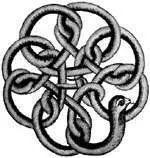 Kundalini is usually given the image of a curled up serpent. When awakened, it slithers up the vertical line where the seven chakras are seated. The serpent slithers upward in a spiral, not at all in a straight line. The same is true for qi. It moves in spirals, even when its direction is straight. That can be compared to the slithering of the serpent, or for that matter the rotation of a bullet when it leaves the barrel of a gun.
Kundalini is usually given the image of a curled up serpent. When awakened, it slithers up the vertical line where the seven chakras are seated. The serpent slithers upward in a spiral, not at all in a straight line. The same is true for qi. It moves in spirals, even when its direction is straight. That can be compared to the slithering of the serpent, or for that matter the rotation of a bullet when it leaves the barrel of a gun.
A more widely used symbol for medicine, also in ancient times, is the rod of Asclepius. It has no wings, and only one serpent, slithering upward. According to the myth, Asclepius, son of the Greek god Apollo, was a formidable practitioner of medicine.
For the exercises here, it is not necessary to ponder the spiral nature of qi, but it is good to know. A consequence of it is that recurring movements awaken qi better than solitary ones, and whirling movements stimulate qi more than straight ones. Actions filled with qi contain more movement than what is visible on the surface – much more. It can be compared to breathing out silently or setting a tone to it – humming, talking, or singing. Qi kind of sings all the time. You can call it vibration. The term is often used about it. The important thing is to see the movement as three-dimensional. It is not only a sinus curve, but the spiral that is the result if the sinus curve is given a third dimension. Maybe that is why you can get dizzy from an increased qi flow. Dizziness is a whirling feeling, not a linear one. So, dizziness is a very natural state, which can explain why people of all times have been eager to use drugs and other means to induce it. Anyway, qi gives dizziness for free, without any hazard to the health.
This is the opening chapter of my book Qi: Increase your Life energy.
My Books About Life EnergyHere are the two books I have written on the subject of life energy. This website contains some of the material from the first one. Click the image to see the book at Amazon (paid link).
About CookiesMy Other WebsitesLife EnergyThe many life force beliefs all over the world, ancient and modern, explained.
TaoisticTaoism, the old Chinese philosophy of life, based on Tao, the Way. Also, the complete Tao Te Ching translated and explained.
AikidoAikido, the peaceful martial art. Its basics, principles, techniques, and more — in texts, images and videos.
I Ching OnlineThe 64 hexagrams of the Chinese classic I Ching and what they mean in divination. Free online reading.
Other Books by MeClick the image to see the book at Amazon (paid link).

Stefan StenuddAbout Me I'm a Swedish author and aikido instructor. I've written several books about aikido, qi energy and other life force concepts. I'm also an historian of ideas, researching the thought patterns in creation myths. Click the image to get to my personal website. Contact
|
 Qi — Increase Your Life Energy
Qi — Increase Your Life Energy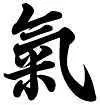 Already how qi is written in Chinese shows an equal relation to qi and air, as that of oxygen and air. The pictogram consists of two parts: one is the sign for steam, and inside of it is the sign for rice. Boiling rice, the basic nutrition for all of East Asia. The body can only digest the rice if it is boiled, and then it is the completely dominating food of the Chinese and the Japanese. It has kept them alive through countless generations. That is life energy, indeed.
Already how qi is written in Chinese shows an equal relation to qi and air, as that of oxygen and air. The pictogram consists of two parts: one is the sign for steam, and inside of it is the sign for rice. Boiling rice, the basic nutrition for all of East Asia. The body can only digest the rice if it is boiled, and then it is the completely dominating food of the Chinese and the Japanese. It has kept them alive through countless generations. That is life energy, indeed.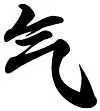 When qi is written without the sign for rice, it simply means air. So the complete pictogram points out that the life supporting essence is inside the air, just like oxygen.
When qi is written without the sign for rice, it simply means air. So the complete pictogram points out that the life supporting essence is inside the air, just like oxygen.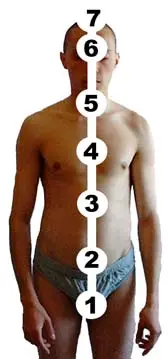 The seven chakras and their approximate meanings are, from the bottom up:
The seven chakras and their approximate meanings are, from the bottom up: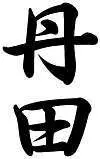 The Chinese call this chakra dantian, and the Japanese say tanden. It is written with two signs, one meaning cinnabar red, and the other rice field. The red rice field. So, rice appears again in connection with qi – this time a whole field of it, and red at that, as if glowing. So the word implies a massive reserve of power, a great resource we have inside of us. That is why the Chinese and the Japanese get their strength from the belly.
The Chinese call this chakra dantian, and the Japanese say tanden. It is written with two signs, one meaning cinnabar red, and the other rice field. The red rice field. So, rice appears again in connection with qi – this time a whole field of it, and red at that, as if glowing. So the word implies a massive reserve of power, a great resource we have inside of us. That is why the Chinese and the Japanese get their strength from the belly. A pair of slithering serpents is found on the caduceus, the winged staff that belongs to the Greek god Hermes (the Roman god Mercury). It is sometimes used as a symbol for medicine. In the myth, Hermes threw his staff between two snakes, to stop them from fighting each other.
A pair of slithering serpents is found on the caduceus, the winged staff that belongs to the Greek god Hermes (the Roman god Mercury). It is sometimes used as a symbol for medicine. In the myth, Hermes threw his staff between two snakes, to stop them from fighting each other.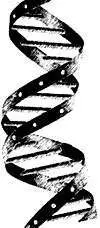 So much in nature moves in spirals, even when the impression is that of a straight line. This is indeed the case with celestial mechanics, the movement of heavenly bodies through space. Galaxies are usually shaped like spirals. Planets and comets move not in circles but in ellipses around their star. And in the microcosm, there is the spiral shape of the genes, the waves of light and sound, and so on. The straight line is as rare as it is unnatural in our cosmos. Everything curves, winds, spins, and twirls, like in a joyous dance.
So much in nature moves in spirals, even when the impression is that of a straight line. This is indeed the case with celestial mechanics, the movement of heavenly bodies through space. Galaxies are usually shaped like spirals. Planets and comets move not in circles but in ellipses around their star. And in the microcosm, there is the spiral shape of the genes, the waves of light and sound, and so on. The straight line is as rare as it is unnatural in our cosmos. Everything curves, winds, spins, and twirls, like in a joyous dance.


